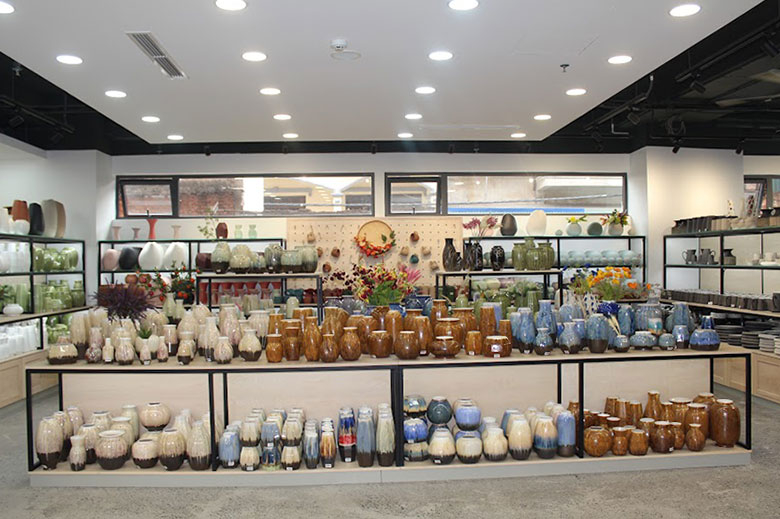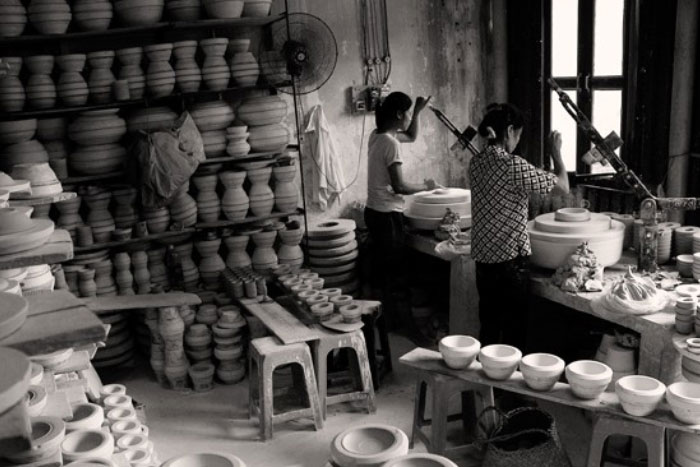News
Discovering Bat Trang Ancient Village – Vietnam’s Timeless Pottery Heartland
Bat Trang ancient village, a renowned pottery hub in Vietnam, has captivated travelers and artisans alike for centuries. Nestled on the outskirts of Hanoi, this historic village offers a vivid glimpse into traditional Vietnamese craftsmanship, culture, and community life. Exploring Bat Trang ancient village means stepping into a world where age-old techniques meet vibrant cultural expression, making it an essential destination for cultural enthusiasts and collectors.
Visitors to Bat Trang ancient village can immerse themselves in the art of pottery-making, observe master artisans at work, and even try their hand at crafting unique ceramics. Whether you are a tourist seeking authentic souvenirs or an artist looking for inspiration, understanding how to use Bat Trang ancient village as a cultural and creative resource can greatly enrich your experience.
The Historical Roots of Bat Trang Ancient Village

Understanding the origins and evolution of Bat Trang ancient village lays the foundation for appreciating its significance in Vietnam’s heritage.
The history of Bat Trang ancient village dates back over 700 years, making it one of Vietnam’s oldest craft villages. This section explores the historical context that shaped its development into a premier pottery center.
Origins and Early Development
Bat Trang’s location along the Red River delta was fundamental in its establishment. The rich alluvial soil provided perfect clay materials, while river access facilitated trade routes, allowing early villagers to export their products widely.
The village initially formed around family clans specializing in pottery, passing skills through generations. Artisans developed distinct styles and techniques that were influenced by dynastic changes and external trade relations.
Evolution Through Dynasties
Throughout various Vietnamese dynasties, Bat Trang ancient village experienced periods of both flourishing growth and decline. Under the Le and Nguyen dynasties, demand for ceramics surged due to increased domestic consumption and exportation to other Asian countries.
Royal patronage also elevated the status of Bat Trang pottery, encouraging innovation in design and glazing methods. Historical artifacts from these periods demonstrate exquisite craftsmanship and artistic diversity.
Influence of Colonial and Modern Eras
The French colonial period introduced new market dynamics and technologies to Bat Trang. While some traditional methods were overshadowed, artisans adapted by integrating Western aesthetics with local techniques.
In modern times, the village balances preserving its heritage with commercial tourism pressures. Conservation efforts and community initiatives strive to maintain the authenticity of Bat Trang’s ancient craft traditions.
Craftsmanship and Techniques in Bat Trang Ancient Village

The true jewel of Bat Trang ancient village lies in its extraordinary pottery-making craftsmanship, which continues to thrive today.
Before diving into the specifics, it’s important to recognize the artistry behind every ceramic piece produced here is a blend of precision, creativity, and cultural symbolism.
Traditional Pottery Methods
Pottery in Bat Trang begins with sourcing high-quality clay from nearby quarries. Artisans meticulously prepare the clay, removing impurities to ensure durability and texture.
Hand-throwing on potter’s wheels remains central to shaping items like bowls, vases, and teapots. This labor-intensive process demands skilled coordination and deep knowledge passed down through families.
Glazing and Decoration
A significant characteristic distinguishing Bat Trang ceramics is their unique glazing techniques. Natural ash glazes and mineral pigments produce the signature warm tones ranging from earthy browns to glossy whites.
Decoration often features motifs inspired by nature, mythology, and daily life, painted with fine brushes. Techniques such as incising, stamping, and carving add depth and detail.
Innovation Amid Tradition
While upholding heritage, contemporary artisans experiment with new forms and designs to appeal to global markets. Collaborations between traditional craftsmen and modern designers have introduced innovations, blending old-world charm with modern aesthetics.
This dynamic tension between preservation and innovation ensures Bat Trang pottery remains relevant while honoring its roots.
Experiencing Bat Trang Ancient Village Today
Visiting Bat Trang ancient village offers a hands-on cultural journey beyond just sightseeing. Travelers gain insight into centuries-old practices and the vibrant community sustaining them.
Let’s explore what visitors can expect and how to maximize the experience.
Touring Pottery Workshops
Most homes in Bat Trang double as workshops. Visitors are welcome to observe artisans shaping clay or glazing finished pieces. These intimate settings provide personal stories and demonstrations, enriching cultural understanding.
Some workshops offer interactive sessions where guests can try wheel-throwing or hand-painting pottery under expert guidance.
Cultural Attractions and Markets
Apart from pottery studios, the village hosts traditional festivals and exhibitions celebrating ceramic arts. Bat Trang’s bustling market sells not only ceramics but also local foods, textiles, and handicrafts.
Exploring these markets reveals the intertwined nature of craft, commerce, and community in the village’s social fabric.
Practical Tips for Visitors
To fully enjoy Bat Trang ancient village, plan your visit during weekdays to avoid crowds and secure workshop participation. Hiring a local guide can deepen appreciation of pottery techniques and historical anecdotes.
Respectful engagement with artisans, such as purchasing genuine handmade products, supports sustainable tourism and helps preserve the village’s cultural legacy.
Comparing Bat Trang Ancient Village to Other Ceramic Traditions

Bat Trang ancient village holds a unique place among global pottery centers, yet it shares intriguing similarities and contrasts with other traditions.
By comparing Bat Trang to other famed ceramic hubs, we gain broader perspectives on its distinctive qualities.
Bat Trang vs. Jingdezhen (China)
Jingdezhen, known as China’s porcelain capital, produces fine translucent porcelain, often elaborate and large-scale. Bat Trang focuses more on stoneware with earthy textures and simpler elegance.
While Jingdezhen emphasizes imperial-style ceramics, Bat Trang’s pieces reflect rural life and folk art influences.
Bat Trang vs. Staffordshire (England)
Staffordshire pottery is famous for industrial production and mass-market ceramics. In contrast, Bat Trang maintains artisanal, handcrafted processes with individual artisan signatures rather than factory outputs.
Both regions value tradition but operate within different economic and technological frameworks.
Bat Trang vs. Mashiko (Japan)
Mashiko pottery highlights rustic simplicity and natural beauty, sharing philosophical parallels with Bat Trang’s aesthetic values. However, Japanese pottery often integrates Zen concepts, prioritizing asymmetry and imperfection.
Bat Trang pottery tends to show more decorative motifs and colorful glazes reflecting Vietnamese cultural identity.
Practical Insights and Advice for Engaging with Bat Trang Ancient Village
Making the most out of your visit or study of Bat Trang ancient village requires thoughtful preparation and cultural sensitivity.
Here are valuable pointers based on experience and research:
How to Use Bat Trang Ancient Village as a Learning Resource
Whether for academic research, artistic inspiration, or cultural exploration, Bat Trang offers rich material. Attending workshops, interviewing artisans, and documenting techniques firsthand provide immersive learning opportunities.
Engage with local experts to understand contextual histories behind specific styles or tools.
Examples of Meaningful Souvenirs
When shopping, prioritize authentic ceramics crafted by recognized artisans to support the community. Items like tea sets, decorative plates, or small sculptures carry cultural significance and make durable keepsakes.
Avoid mass-produced imitations that lack the craftsmanship and innovation emblematic of Bat Trang.
Advice for Ethical Tourism
Respect local customs and intellectual property rights of artisans. Ask permission before photographing workshops. Pace your activities to allow meaningful interactions rather than superficial visits.
Contributing to community sustainability helps preserve Bat Trang ancient village’s heritage for future generations.
Summary Table: Key Features of Bat Trang Ancient Village
| Feature | Description |
|---|---|
| Location | Near Hanoi, Vietnam |
| Age | Over 700 years |
| Primary Craft | Stoneware pottery, hand-thrown and glazed |
| Cultural Significance | Important historical ceramic center |
| Visitor Activities | Workshop tours, pottery classes, markets |
| Unique Qualities | Traditional techniques, vibrant decorations |
| Comparison Highlights | More artisanal than mass-produced centers |
Conclusion
Bat Trang ancient village stands as a vibrant testament to Vietnam’s enduring pottery traditions, blending history, artistry, and community life. From its origins steeped in natural resources and dynastic patronage to its current role as a living museum and creative hub, Bat Trang invites visitors to engage deeply with cultural craftsmanship. Whether comparing it to other world-famous ceramic centers or immersing oneself in hands-on workshops, the village offers unparalleled insights into the art of pottery. Approaching Bat Trang with respect and curiosity ensures a rewarding experience that honors both the past and present of this treasured craft enclave.
